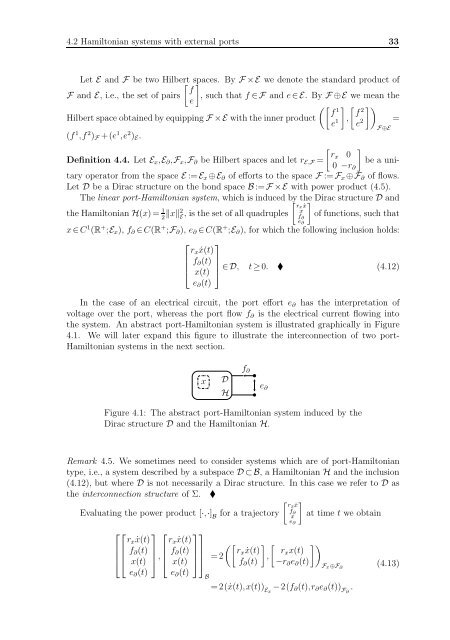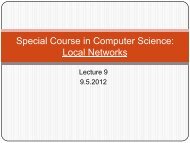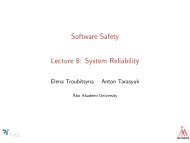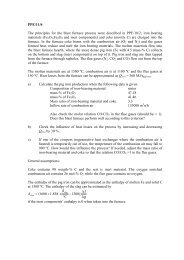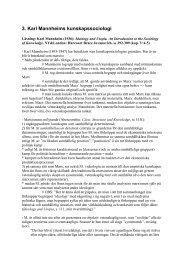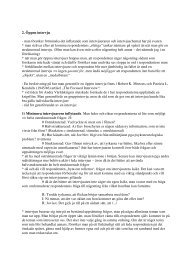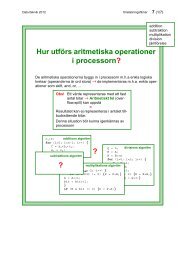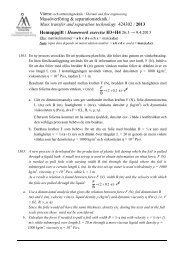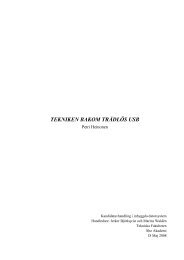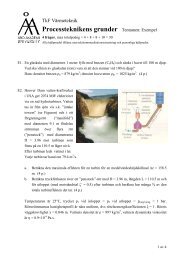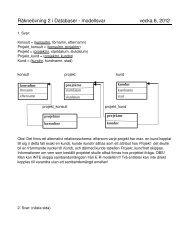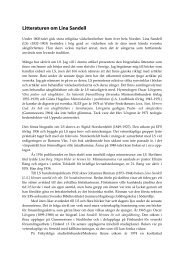Mikael Kurula - Åbo Akademi
Mikael Kurula - Åbo Akademi
Mikael Kurula - Åbo Akademi
You also want an ePaper? Increase the reach of your titles
YUMPU automatically turns print PDFs into web optimized ePapers that Google loves.
4.2 Hamiltonian systems with external ports 33<br />
Let E and F be two Hilbert spaces. By F ×E we denote the standard product of<br />
f<br />
F and E, i.e., the set of pairs , such that f ∈ F and e ∈ E. By F ⊕E we mean the<br />
e<br />
<br />
1 f<br />
Hilbert space obtained by equipping F ×E with the inner product<br />
e1 <br />
2 f<br />
,<br />
e2 <br />
=<br />
F⊕E<br />
(f 1 ,f 2 )F +(e 1 ,e 2 )E.<br />
<br />
rx 0<br />
Definition 4.4. Let Ex,E∂,Fx,F∂ be Hilbert spaces and let rE,F = be a uni-<br />
0 −r∂<br />
tary operator from the space E := Ex ⊕E∂ of efforts to the space F := Fx ⊕F∂ of flows.<br />
Let D be a Dirac structure on the bond space B := F ×E with power product (4.5).<br />
The linear port-Hamiltonian system, which is induced by the Dirac structure D and<br />
of functions, such that<br />
the Hamiltonian H(x)= 1<br />
2x2E , is the set of all quadruples<br />
x ∈C 1 (R + ;Ex), f∂ ∈C(R + ;F∂), e∂ ∈C(R + ;E∂), for which the following inclusion holds:<br />
rx ˙x<br />
x<br />
f∂<br />
e∂<br />
⎡ ⎤<br />
rx ˙x(t)<br />
⎢ f∂(t) ⎥<br />
⎣ x(t) ⎦ ∈ D,<br />
e∂(t)<br />
t ≥0. (4.12)<br />
In the case of an electrical circuit, the port effort e∂ has the interpretation of<br />
voltage over the port, whereas the port flow f∂ is the electrical current flowing into<br />
the system. An abstract port-Hamiltonian system is illustrated graphically in Figure<br />
4.1. We will later expand this figure to illustrate the interconnection of two port-<br />
Hamiltonian systems in the next section.<br />
x<br />
D<br />
H<br />
Figure 4.1: The abstract port-Hamiltonian system induced by the<br />
Dirac structure D and the Hamiltonian H.<br />
Remark 4.5. We sometimes need to consider systems which are of port-Hamiltonian<br />
type, i.e., a system described by a subspace D ⊂ B, a Hamiltonian H and the inclusion<br />
(4.12), but where D is not necessarily a Dirac structure. In this case we refer to D as<br />
the interconnection structure of Σ. <br />
<br />
Evaluating the power product [·,·] B for a trajectory<br />
⎡⎡<br />
⎤<br />
rx ˙x(t)<br />
⎢⎢<br />
⎢⎢<br />
f∂(t) ⎥<br />
⎣⎣<br />
x(t) ⎦<br />
e∂(t)<br />
,<br />
⎡ ⎤⎤<br />
rx ˙x(t)<br />
⎢ f∂(t) ⎥⎥<br />
⎥⎥<br />
⎣ x(t) ⎦⎦<br />
e∂(t)<br />
=2<br />
f∂<br />
e∂<br />
rx ˙x<br />
f∂ x<br />
e∂<br />
at time t we obtain<br />
<br />
rx ˙x(t) rxx(t)<br />
,<br />
f∂(t) −r∂e∂(t)<br />
Fx⊕F∂<br />
B<br />
=2( ˙x(t),x(t)) −2(f∂(t),r∂e∂(t)) Ex F∂ .<br />
(4.13)


